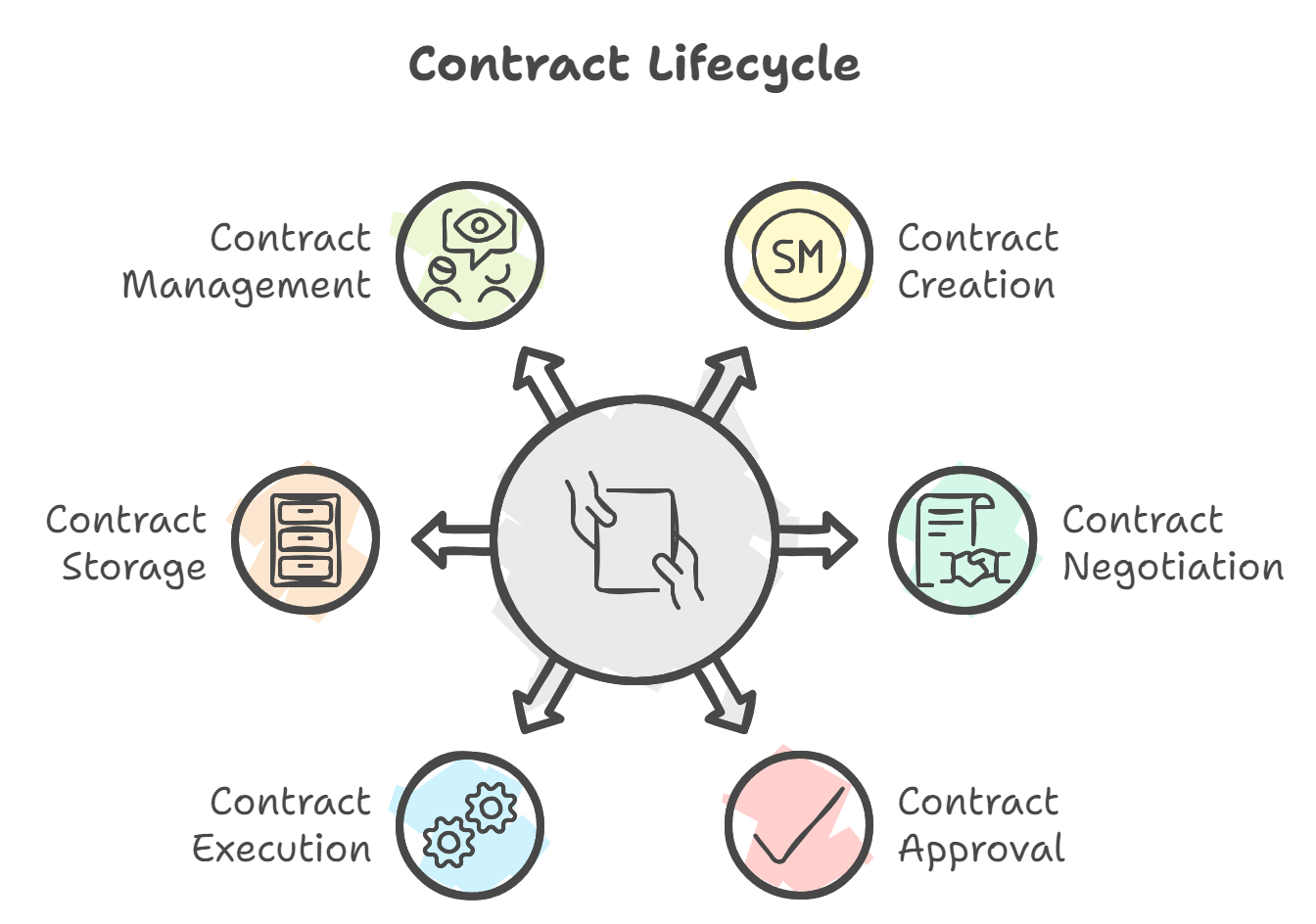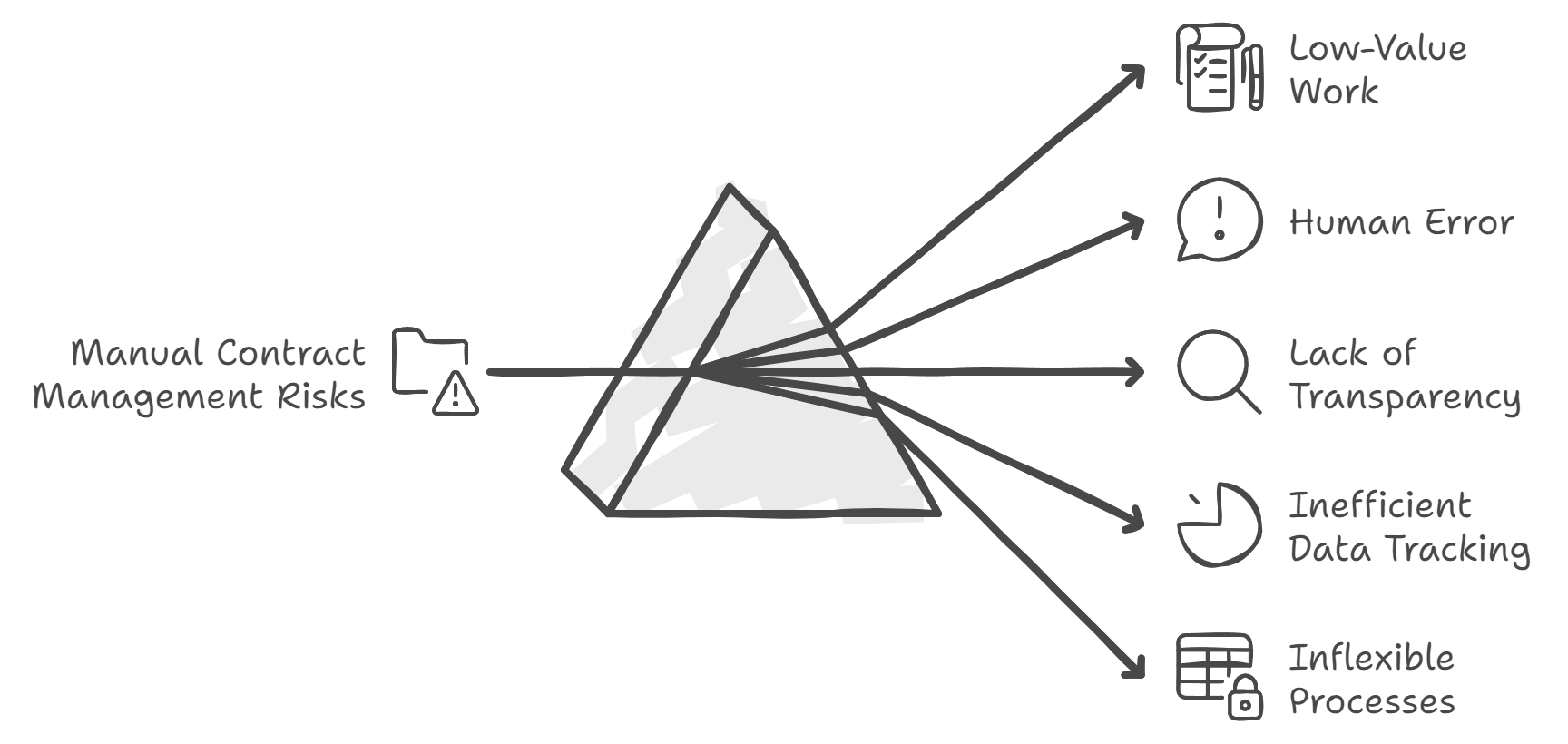Contract Lifecycle Management (CLM)
Contract Lifecycle Management (CLM) is the effective management of contracts and relationships between organizations through proper planning of all phases of contract management, resulting in the reduction, elimination or mitigation of financial and legal risks.
What is Contract Lifecycle Management (CLM)?
Contract Lifecycle Management (CLM) is the careful process of managing contracts in terms of their creation, review, approval, execution, and archiving. By keeping track of these lifecycles of a contract, one can understand how it evolves through the contract phases from draft to execution and possibly renewal. CLM software can lead to significant cost savings and efficiency improvements. Using a contract lifecycle management solution can also limit a company’s risk by reducing missed commitments and improving regulatory compliance.
What is a Contract Lifecycle?
A contract lifecycle is the process by which a contract is created and managed. It describes the various stages that a contract must go through, from drafting to post-signature tracking.
Although certain business contracts linger longer in certain phases of the Contract Lifecycle than others, most contracts follow the same vague process. They are created, reviewed, negotiated, signed, tracked and renewed in that order. However, because contracts are complex legal documents, it is not uncommon for them to move back and forth throughout the contract lifecycle.
When a contract is negotiated, it is likely to return to the review phase after changes are made by a counterparty. If the changes are accepted, the contract is approved by the appropriate parties before it can be signed - usually with approval workflows.
Phases of Contract Lifecycle Management
A contract lifecycle usually consists of the following 6 phases, which are digitally mapped in a Contract Lifecycle Management:



The phases of the contract lifecycle.
1. Contract creation
Simply put, Contract creation is how companies create contracts, whether from a template or from scratch. This phase of contract lifecycle management is also referred to as drafting or creation. Microsoft Word documents and PDF files are often used as the standard for contract files, so document creation software solutions focus on the ability to custom Word and PDF creation or export to this format.
2. Contract negotiation
After contracts are created, but before they are signed, they may need to be negotiated with contractors. During contract negotiations, processors on both sides need to be able to track changes, comments, and versions of documents. This is an important phase of contract lifecycle management.
3. Contract approval
In small companies, an executive or legal officer may be able or required to review and approve every part of a contract on his or her own. However, as a company grows, functional and regional departments typically need to approve different parts of a contract. Contract lifecycle management software automates and tracks approval progress and sends out reminders.
4. Contract execution
Once both parties are ready to agree to a contract, they sign it. This step presents an interesting logistical and technical challenge for contract lifecycle management, as the predominant tools for this step - eSignature solutions - are often sold as separate solutions. However, good Contract Lifecycle Management software also maps the eSignature process in one system.
5. Contract storage
There are different levels of contract storage. The most basic requirement is that contracts are stored securely. However, it is also important that corporate folders are easy to navigate, that metadata is recorded in a database to allow easy reporting and filtering (for example, displaying all contracts with a value over EUR 10,000), and that the contextual history of a contract is stored - not just the executed contract itself. The storage of contracts is an excellent example of the need for professional contract lifecycle management, not only to store contracts, but more importantly to search and classify them.
6. Contract management and analytics
The final phase of contract lifecycle management is contract management and analytics, which includes everything from contract management and search to contract renewal and analysis. This phase is very essential and often underestimated as it provides the foundation to learn and draw conclusions from your own contract data.
Summary
Managing the contract lifecycle with a uniform contract lifecycle management increases transparency and legal certainty while minimizing risk. Contracts are stored and managed uniformly on a central database.
Why is the use of contract lifecycle management so important?
At some point in any business growth, increasing contract volume makes it difficult to manage contracts with Word, Excel, and shared drives. Legal teams face three basic but important questions that make contract management confusing:
- Where can I find the latest versions of contracts? Have the contracts been signed? Have they been amended? Where are the relevant attachments?
- What is in my contracts? All contracts should contain the most current and risk-adjusted terms and conditions.
- Who is responsible for this contract? Who is responsible for performing the required actions at each stage of the contract lifecycle?
These are the issues that typically cause companies to consider implementing contract lifecycle management.
The risks of manual contract lifecycle management
Maintaining a manual approach to Contract Lifecycle Management has some very specific risks.



Risks of manual contract management.
1. Lawyers do low-value work
Without a solid structure and contract lifecycle management in place, business teams will continue to rely on legal for advice - even on routine contracts. As legal’s time is consumed by these low-value, routine tasks, in-house legal teams run the risk of missing important deadlines for higher value work.
2. Likelihood of human error increases
Mistakes and errors in legal contracts can be costly. Without a digital contract lifecycle management solution, corporate teams attempting to handle contracts themselves may neglect standardized wording, forget to enter important data, or neglect important information. All of this can jeopardize both contract fulfillment and the relationship with the counterparty in the long run.
3. Lack of transparency
Today, many contracts require collaboration to complete successfully. Without a digital contract lifecycle management solution, business contracts are often created and shared manually, resulting in multiple versions and little control. This also means that comments, amendments and changes can get lost in the manual process, creating additional work for legal teams.
4. Inefficient way to track data
Without a single, unified workspace and automated data collection capabilities, manual contract lifecycle management can result in incomplete or inaccurate data. Given the many valuable contract metrics to track, this is a missed opportunity that can cost organizations dearly - especially if renewal dates and potential risk areas are not identified and addressed.
5. Lack of flexibility
Manual contract lifecycle management is not very flexible, which can be a problem with complex contracts that require back and forth and many edits. Instead of quickly modifying or commenting on contracts, counterparties and colleagues must create new versions of a document, submit them, and wait for the counterparty to confirm.
What is CLM Software?
Contract Lifecycle Management (CLM) software is a solution that automates and streamlines the process of creating, executing and managing contracts. It aims to simplify the contract management process by digitizing and automating key steps such as document creation, electronic signature, and contract storage. This type of software is especially useful for companies that deal with a large number of contracts on a regular basis, as it allows them to manage these agreements more efficiently while reducing the risk of errors or compliance issues.
Features of CLM Software
One of the main benefits of CLM software is that it streamlines the contract creation process by automating document creation and ensuring consistency across all contracts. This can help reduce the risk of errors and ensure compliance with legal and regulatory requirements. In addition, CLM software allows companies to easily track and monitor the status of contracts, including key milestones and deadlines, which helps ensure that all contractual obligations are met on time.
Another important feature of CLM software is the ability to electronically sign and store contracts. This eliminates the need for physical signatures and paper contract storage, which increases efficiency and security. With the e-signature feature, parties to a contract can sign and approve documents at any time and from any location, eliminating delays caused by printing, signing and mailing physical documents. In addition, by digitizing and electronically storing contracts, companies can access, search and retrieve important contract details at any time.
One of the most important uses of CLM software is in corporate legal departments. Since legal departments are responsible for creating, reviewing and managing contracts, CLM software can be extremely helpful in automating and streamlining the contract management process. This includes automating document creation, implementing electronic signatures, and providing a user-friendly contract management system. Legal teams can also use CLM software to monitor contract milestones and deadlines and ensure compliance with legal and regulatory requirements.
Another area where CLM software can be particularly useful is procurement and supply chain management. Procurement professionals are responsible for managing a large number of contracts with suppliers, and CLM software can help streamline the process of creating and managing these agreements. This includes automating document creation, tracking key milestones and deadlines, and ensuring compliance with legal and regulatory requirements.
Summary
Contract Lifecycle Management helps organizations minimize contract risk, ensure compliance, review contracts for performance, and stay organized from start to finish. Effective contract lifecycle management means cost and time savings for any organization.
Contracts can be enjoyable. Get started with fynk today.
Companies using fynk's contract management software get work done faster than ever before. Ready to give valuable time back to your team?
Schedule demo

